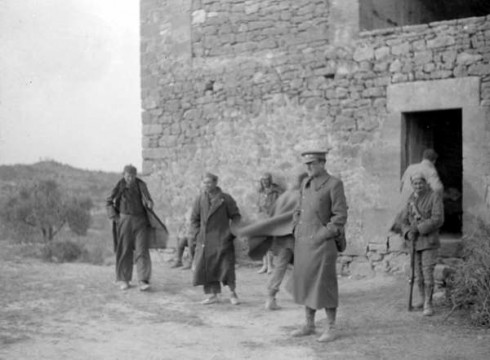Spain, Again…

Dan and others walk through the Ebro Valley, the scene of some of the great struggles of the Spanish Civil War
The dead sleep cold in Spain tonight. Snow blows through
the olive groves, sifting against the tree roots. Snow drifts
over the mounds with small headboards. For our dead are a
part of the earth of Spain now and the earth of Spain can
never die. Each winter it will seem to die and each spring it
will come alive again. Our dead will live with it forever.
–Ernest Hemingway
By DAN BESSIE
Don Quixote, had he ventured out of La Mancha today and into the Ebro River valley from whence we’ve just returned, might well be terrified by the 150 or more gigantic white windmills dotting the landscape. Installed to generate electricity for Spain, the workers constructing these behemoths also uncovered the unmarked graves of hundreds of Catalan and Spanish, as well as American, British, Canadian and other international dead of whom Hemingway speaks—some of the 35,000 or more volunteer soldiers who came to the aid of the Spanish Republic during the late 1930s, in its heroic but failed effort to prevent the country’s takeover by the Falangist general Franco—aided by his fascist pals, Hitler and Mussolini.
While the wind turbines add a stark new dimension to the landscape, and while the roads are no longer the rough, dust-clogged byways of 1938 experienced by my father Alvah when he served for a year with the Abraham Lincoln Brigade of American volunteers, I know he’d recognize the terrain; it’s little changed. The same villages are there; Batea, Corbera, Gandesa, Fatarella, Darmos—perched on hillsides or spread out along the Ebro. The olives still proliferate, along with almonds, peach, pear, cherry and orange trees. In spring, the land is covered with wild poppies.
Though Jeanne and I had visited the area three times before, mainly in connection with the filming of producer-director Oriol Porta’s fine documentary, Hollywood Contra Franco (an examination of how American films viewed the Spanish Civil War), this most recent trip provided unexpected and emotionally moving surprises: visits to actual sites at which Alvah and his fellow brigadistas had fought and where many died—the very places he wrote about in his classic memoir Men in Battle, and in the daily record he kept during the war, published as Alvah Bessie’s Spanish Civil War Notebooks.
There were dugouts the soldiers had sheltered in from Franco’s bombers and screaming artillery shells, the trench grave of a still unknown very tall soldier, a huge cave serving as brigade headquarters, a great lime-washed stone house that had been used as a medical center, roads that brigadistas had trudged along when the Republic’s massive Ebro offensive designed to halt Franco’s advance was itself halted and the loyalist army had to retreat.
Guided by Alan Warren, a student of the war and especially of the history of the American, British and Canadian brigades, our journey along the Ebro began with an evening lecture by Anna Martî Centellas, a marvelous researcher who, following Alvah’s writing and other materials, has uncovered previously unknown information about still extant locations that matched photos taken during the 1930s. Offering a moving slide presentation to a sizeable audience of mainly Catalan locals, Anna documented the course of battle along the Ebro, the routes followed by the brigades, comparative “then and now” images of locations, and ended with a succession of photos that had much of the audience in tears; photos of many of the volunteers killed during the battles.
The next day, some 50 of us, led by Anna, trekked 30 km through the hills, tracing the probable route taken by the volunteers following the stalling of the Ebro offensive. Jeanne and I walked part of the time, but also drove off with Alan Warren on a few occasions to see several of the recently discovered nearby sites where Alvah and the Lincoln Brigade had been.
Another entire day was spent driving through the hills to visit additional sites, along with Alan and with Joan (pronounced Juan) Sambro and his friend Jordi. Joan, a local farmer, grew up after the war, but his family’s land includes several of the sites we visited; some where he had played as a boy, though with little knowledge then of their history.
Today, he has become a dedicated amateur historian, one of several who, with the help of people such as Anna and Alan, are working to recover the historical memory that Franco and his right wing government had tried to obliterate.
All in all, a tremendously moving experience. But Jeanne and I still wonder—what would Don Quixote do if confronted with those gigantic white windmills?







